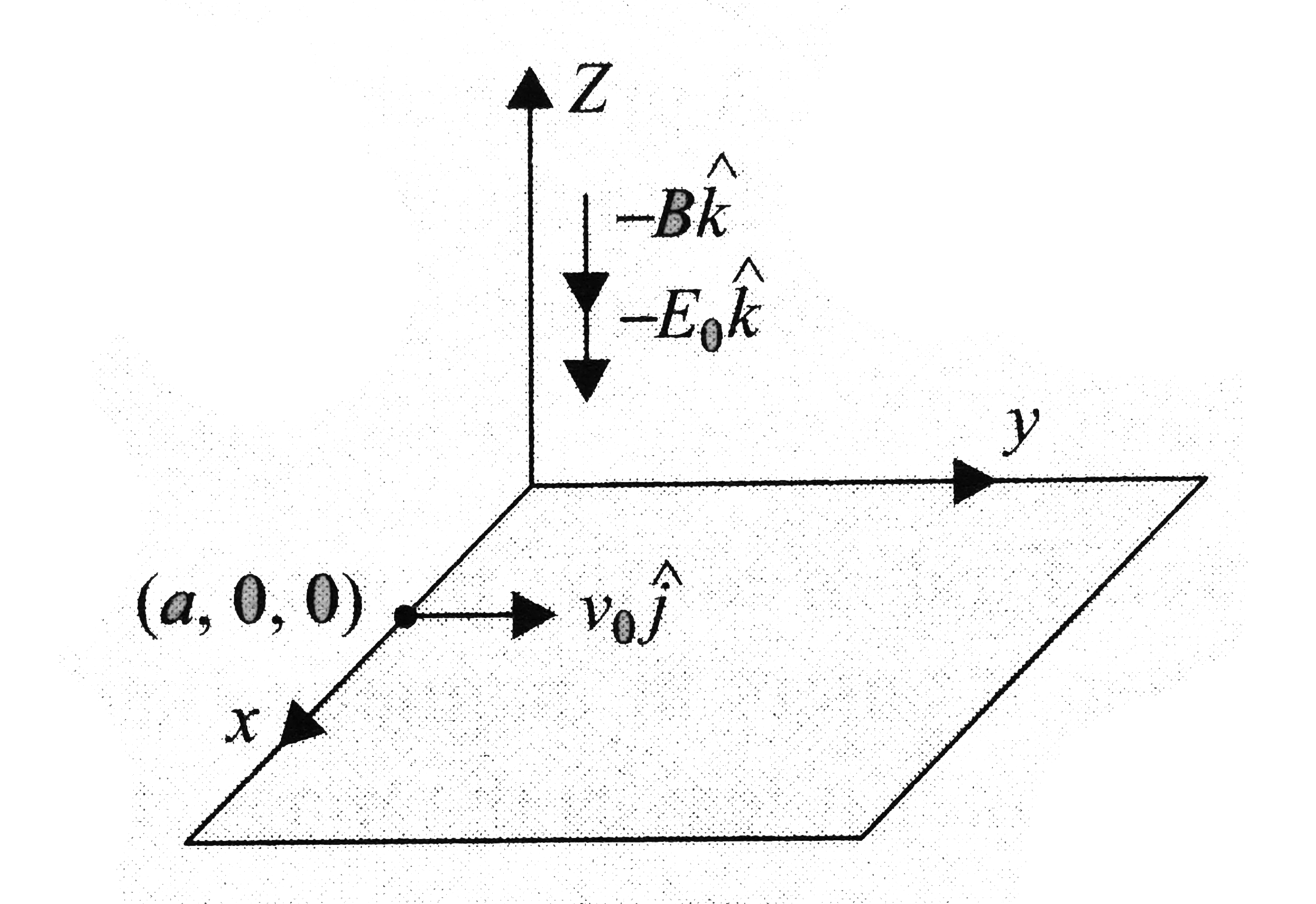A charged particle of mass m and charge q is projected on a rough horizontally xy− plane surface with z− axis in the vertically upward direction. Both electric and magnetic fields are acting in the region and given by →E=−E0ˆk and →B=−B0ˆk respectively. The particle enters into the field at (a,0,0) with velocity →v=υ0ˆj. The particle starts moving into a circular path on the plane. If the coefficient of friction between the particle and the plane is μ. Then calculate tha :

(a) time when the particle will come to rest
(b) time when the particle will hit the centre.
(c) distance travelled by the particle when it comes to rest.
(a)N=mg+qE0……………….(1)
qB0υ=mυ2R………………(2)
and −mdυdt=μN…………………(2)
From equation (2), R=mυB0q……………..(4)
From equations (1) and (3)
−m.dυdt=μ(mg+qE0)(or)
−m∫0v0dυ=μ(mg+qE0)∫t0dt
Thus t=mυ0μ(mg+qE0)
(b) From equation (4)
dR=mB0qdυ=−μ(mg+qE0)dtqB0
∫0R1dR=−μ(mg+qE0)qB0∫t0dt
or ort=qB0Riμ(mg+qE0)
Here Ri=mυ0B0q Thust=mυ0μ(mg+qE0)
(c) −mυ.dυdl=μ(mg+qE0) or,
−m∫0υ0υdυ=μ(mg+qE0)∫t0dt or
l=mυ202μ(mg+qE0)
Related Playlists
- BOOK - NARAYNACHAPTER - MOVING CHARGES AND MAGNETISMEXERCISE - Level =I (H.W)42videos
MOVING CHARGES AND MAGNETISM
- BOOK - NARAYNACHAPTER - MOVING CHARGES AND MAGNETISMEXERCISE - Level -II (H.W)37videos
MOVING CHARGES AND MAGNETISM
- BOOK - NARAYNACHAPTER - MOVING CHARGES AND MAGNETISMEXERCISE - LEVEL-V (SINGLE ANSWER QUESTION)85videos
MOVING CHARGES AND MAGNETISM
- BOOK - NARAYNACHAPTER - MAGNETISM AND MATTEREXERCISE - EXERCISE - 4 (SINGLE ANSWER TYPE QUESTION)17videos
MAGNETISM AND MATTER
- BOOK - NARAYNACHAPTER - NUCLEAR PHYSICSEXERCISE - LEVEL-II-(H.W)9videos
NUCLEAR PHYSICS
Similar Questions
A positively charged particle of mass m and charge q is projected on a rough horizontal x-y plane surface with z-axis in the vertically upward direction. Both electric and magnetic fields are acting in the region and given by →E=−E0ˆkand→B=−B0ˆk , respectively. The particle enters into the field at (a0,0,0) with velocity →v=v0ˆj. The particle starts moving in some curved path on the plane. If the coefficient of friction between the particle and the plane is μ. Then calculate the
(a) time when the particle will come to rest
(b) distance travelled by the particle when it comes to rest.
 View Solution
View SolutionA positively charged particle of mass m and charge q is projected on a rough horizontal x-y plane surface with z-axis in the vertically upward direction. Both electric and magnetic fields are acting in the region and given by →E=−E0ˆkand→B=−B0ˆk , respectively. The particle enters into the field at (a0,0,0) with velocity →v=v0ˆj. The particle starts moving in some curved path on the plane. If the coefficient of friction between the particle and the plane is μ. Then calculate the
(a) time when the particle will come to rest
(b) distance travelled by the particle when it comes to rest.
 View Solution
View SolutionA positively charged particle of mass m and charge q is projected on a rough horizontal x-y plane surface with z-axis in the vertically upward direction. Both electric and magnetic fields are acting in the region and given by →E=−E0ˆkand→B=−B0ˆk , respectively. The particle enters into the field at (a0,0,0) with velocity →v=v0ˆj. The particle starts moving in some curved path on the plane. If the coefficient of friction between the particle and the plane is μ. Then calculate the
(a) time when the particle will come to rest
(b) distance travelled by the particle when it comes to rest.
 View Solution
View SolutionA charged particle of mass m and charge q is projected on a rough horizontal XY plane. Both electric and magnetic fields are given by →E=−10ˆkN/C and magnetic field →B=−5→k tesla are present in the region. The particle enters into the magnetic field at (4,0,0)m with a velocity 50→jm/sec. The particle starts into a curved path on the plane. If coefficietn of friction μ=13 between particle and plane, then (qE=2mg,g=10m/s2).
Total distance covered by the particle isView SolutionA charged particle of mass m and charge q is projected on a rough horizontal XY plane. Both electric and magnetic fields are given by →E=−10ˆkN/C and magnetic field →B=−5→k tesla are present in the region. The particle enters into the magnetic field at (4,0,0)m with a velocity 50→jm/sec. The particle starts into a curved path on the plane. If coefficietn of friction μ=13 between particle and plane, then (qE=2mg,g=10m/s2).
Radius of curvature of the path followed by particle, initially isView SolutionA charged particle of mass m and charge q is projected on a rough horizontal XY plane. Both electric and magnetic fields are given by →E=−10ˆkN/C and magnetic field →B=−5→k tesla are present in the region. The particle enters into the magnetic field at (4,0,0)m with a velocity 50→jm/sec. The particle starts into a curved path on the plane. If coefficietn of friction μ=13 between particle and plane, then (qE=2mg,g=10m/s2).
Total work done by electric force on the particle isView SolutionA charged particle of mass m and charge q is projected on a rough horizontal XY plane. Both electric and magnetic fields are given by →E=−10ˆkN/C and magnetic field →B=−5→k tesla are present in the region. The particle enters into the magnetic field at (4,0,0)m with a velocity 50→jm/sec. The particle starts into a curved path on the plane. If coefficietn of friction μ=13 between particle and plane, then (qE=2mg,g=10m/s2).
The time after which particle comes to rest, isView SolutionElectric field and magnetic field in a region of space are given by(Ē=E0ˆj). and (¯¯¯B=B0ˆj). A charge particle is released at origin with velocity (¯v=v0ˆk) then path of particle is
View SolutionElectric field and magnetic field in a region of space are given by(Ē=E0ˆj). and (¯¯¯B=B0ˆj). A charge particle is released at origin with velocity (¯v=v0ˆk) then path of particle is
View SolutionA particle having mass m and charge q is released from the origin in a region in which electric field and megnetic field are given by →B=−B0ˆj and →E=→E0ˆk. Find the speed of the particle as a function of its z-coordinate.
View Solution

